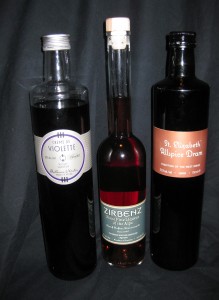While picking up a bottle of Creme de Violette for the esteemed Iconoplast (of HAVE A BREW. DON’T COST NOTHIN fame), my eye was caught by a number of liqueurs on the same shelf. As it turns out, Haus Alpenz imports a variety of interesting spirits. Trying not to get carried away, I picked up the aforementioned Creme de Violette, and decided to take a chance on two others: St. Elizabeth’s Allspice Dram (which immediately garnered the nickname Saint E’s) and Zirbenz “Stone Pine Liqueur of the Alps”, which is essentially booze made from pinecones.
It was time for some cocktails.
Creme de Violette is the Higgs Boson of liqueurs, but I have been able to find a reliable stock at Marty’s Liquors of Newton, which has become something of an addiction lately. It is the rarest of the ingredients to be found in The Aviation…
1 ½ oz. Aviation Gin
½ oz. Rothman & Winter Creme de Violette
½ oz. lemon juice
1 tsp. Luxardo Maraschino
I prefer to add the Violette last to this concoction, letting its regal purple bleed into the cloudy mixture, like squid ink into an aquarium tank. When all mixed, it becomes a cloudy, almost unnatural lavender, and left to sit this cloud condenses into the center of the glass. Letting it sit is for suckers.
The taste is sweet, but not sickeningly so, the lemon juice balancing out the sugary Violette while the gin takes over. The Maraschino is there somewhere, but it’s certainly not obvious, and I’m wondering how the drink would be without it. I’ve found some other recipes online with different proportions of these four ingredients, but the one above is the best tasting one I’ve found so far.
Next up was the Lion’s Tail…
2 oz. Infusion Diabolique Bourbon
½ oz. St. Elizabeth Allspice Dram
½ oz. lime juice
a dash of Angostura bitters
Infusion Diabolique is a locally distilled bourbon infused with figs, cinnamon, and vanilla. I rightly assumed that this would go well with Saint E’s. The recipe also called for four dashes of simple syrup, but I had none on hand and was unsure of how to dash simple sugar anyway.
The resulting cocktail looked not unlike apple cider, the lime juice clouding what would otherwise be a translucent brown liquid. The acid in the lime was all that was left of it upon tasting, as a wonderfully warm and inviting taste hit my tongue; earthy hints of cloves and nutmeg and cinnamon swirled around in my mouth. It was not sharp or biting in the least, and the aftertaste called out to me, saying “I am what should be in your flask this winter.”
Onto the Zirbenz. To be frank, I both feared and respected an alcohol made out of pinecones, and the scent from the open bottle did nothing to change either of those attitudes. It smelled like pine all right, but had a strange sweetness that was evident in the taste as well. The color was reminiscent of pine bark, and the residue at the bottom of the bottle looked like it too. Time for an Alpine Sidecar…
1 oz. Zirbenz Stone Pine Liqueur of the Alps
1 oz. Patron Citrónge
1 oz. lemon juice
I hope you’ll excuse the replacement of Citrónge for Cointreau here; I don’t necessarily mind paying $40 for 750 mL of booze, but I do mind paying $40 for 750 mL of what is essentially triple sec. Citrónge is half the price and has the same alcohol content if not the same taste. Zirbenz replaces the brandy in this sidecar making it Alpine in nature, and giving a vaguely pink tint to it. The result? Decidely drinkable, but not particular noteworthy. It tasted like lemonade with a bit of a kick, and not much more. This probably wasn’t the best cocktail to try out the Zirbenz with, but I was a little timid with it this time around.

One Comment